Planning Methods and Approaches for Heathrow Baggage Handling Project
VerifiedAdded on 2022/10/04
|7
|1483
|18
Report
AI Summary
This report provides a detailed analysis of the planning methods and approaches employed for the Heathrow Baggage Handling Project. It examines various techniques, including brainstorming, cause and effect diagrams, critical path analysis, and Gantt charts, highlighting their application in designing an IT system for the baggage handling process. The report also outlines the project lifecycle, encompassing initiation, planning, organizing, controlling, and closure phases, emphasizing the importance of stakeholder involvement and efficient project management to ensure the project's successful completion within the allocated time and budget. The project aimed to create an innovative and sophisticated baggage handling system for Heathrow Terminal 3, which would integrate with Terminal 5 to manage a high volume of baggage. The report also highlights the need for effective risk management and the role of IT systems in modernizing airport operations.

Running head: PLANNING METHODS AND APPROACHES FOR HEATHROW BAGGAGE HANDLING PROJECT
Planning Methods and Approaches for Heathrow Baggage Handling Project
Name of the Student
Name of the University
Author note
Planning Methods and Approaches for Heathrow Baggage Handling Project
Name of the Student
Name of the University
Author note
Paraphrase This Document
Need a fresh take? Get an instant paraphrase of this document with our AI Paraphraser

1PLANNING METHODS AND APPROACHES FOR HEATHROW BAGGAGE HANDLING PROJECT
Table of Contents
1. Comparison and Contrast over the Planning Methods and Approaches.....................................2
2. Justification for Subsequent Planning Processes.........................................................................3
References........................................................................................................................................6
Table of Contents
1. Comparison and Contrast over the Planning Methods and Approaches.....................................2
2. Justification for Subsequent Planning Processes.........................................................................3
References........................................................................................................................................6
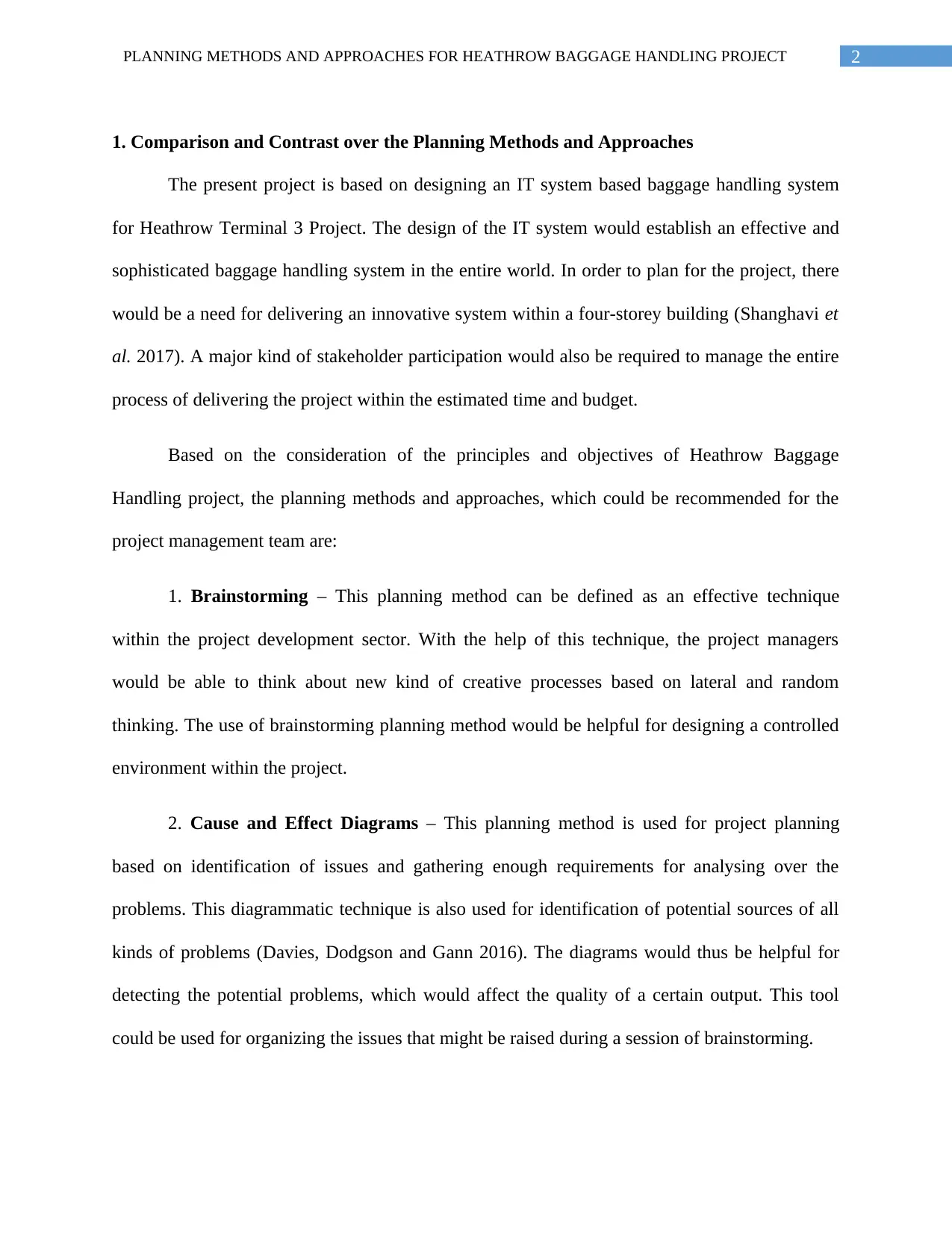
2PLANNING METHODS AND APPROACHES FOR HEATHROW BAGGAGE HANDLING PROJECT
1. Comparison and Contrast over the Planning Methods and Approaches
The present project is based on designing an IT system based baggage handling system
for Heathrow Terminal 3 Project. The design of the IT system would establish an effective and
sophisticated baggage handling system in the entire world. In order to plan for the project, there
would be a need for delivering an innovative system within a four-storey building (Shanghavi et
al. 2017). A major kind of stakeholder participation would also be required to manage the entire
process of delivering the project within the estimated time and budget.
Based on the consideration of the principles and objectives of Heathrow Baggage
Handling project, the planning methods and approaches, which could be recommended for the
project management team are:
1. Brainstorming – This planning method can be defined as an effective technique
within the project development sector. With the help of this technique, the project managers
would be able to think about new kind of creative processes based on lateral and random
thinking. The use of brainstorming planning method would be helpful for designing a controlled
environment within the project.
2. Cause and Effect Diagrams – This planning method is used for project planning
based on identification of issues and gathering enough requirements for analysing over the
problems. This diagrammatic technique is also used for identification of potential sources of all
kinds of problems (Davies, Dodgson and Gann 2016). The diagrams would thus be helpful for
detecting the potential problems, which would affect the quality of a certain output. This tool
could be used for organizing the issues that might be raised during a session of brainstorming.
1. Comparison and Contrast over the Planning Methods and Approaches
The present project is based on designing an IT system based baggage handling system
for Heathrow Terminal 3 Project. The design of the IT system would establish an effective and
sophisticated baggage handling system in the entire world. In order to plan for the project, there
would be a need for delivering an innovative system within a four-storey building (Shanghavi et
al. 2017). A major kind of stakeholder participation would also be required to manage the entire
process of delivering the project within the estimated time and budget.
Based on the consideration of the principles and objectives of Heathrow Baggage
Handling project, the planning methods and approaches, which could be recommended for the
project management team are:
1. Brainstorming – This planning method can be defined as an effective technique
within the project development sector. With the help of this technique, the project managers
would be able to think about new kind of creative processes based on lateral and random
thinking. The use of brainstorming planning method would be helpful for designing a controlled
environment within the project.
2. Cause and Effect Diagrams – This planning method is used for project planning
based on identification of issues and gathering enough requirements for analysing over the
problems. This diagrammatic technique is also used for identification of potential sources of all
kinds of problems (Davies, Dodgson and Gann 2016). The diagrams would thus be helpful for
detecting the potential problems, which would affect the quality of a certain output. This tool
could be used for organizing the issues that might be raised during a session of brainstorming.
⊘ This is a preview!⊘
Do you want full access?
Subscribe today to unlock all pages.

Trusted by 1+ million students worldwide
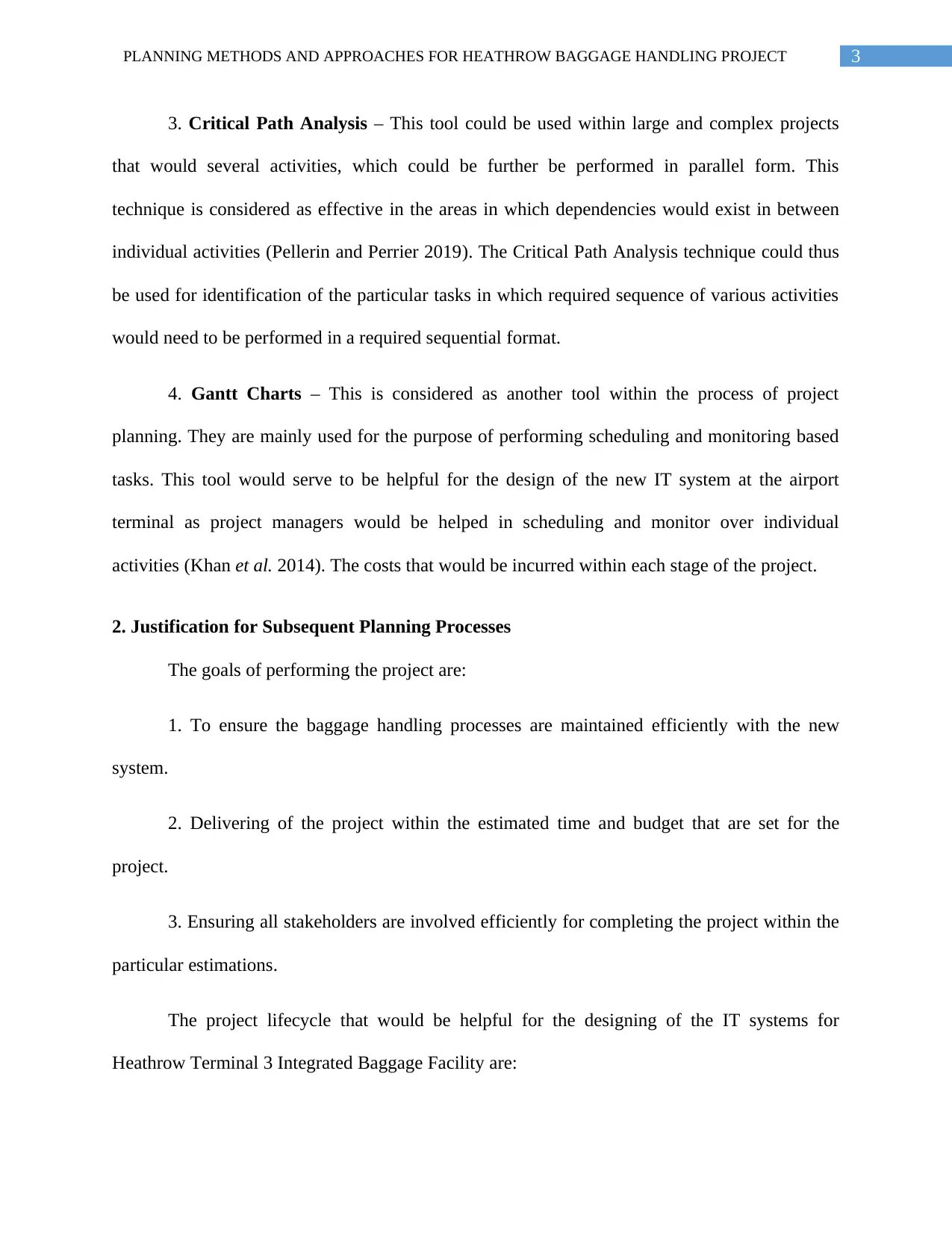
3PLANNING METHODS AND APPROACHES FOR HEATHROW BAGGAGE HANDLING PROJECT
3. Critical Path Analysis – This tool could be used within large and complex projects
that would several activities, which could be further be performed in parallel form. This
technique is considered as effective in the areas in which dependencies would exist in between
individual activities (Pellerin and Perrier 2019). The Critical Path Analysis technique could thus
be used for identification of the particular tasks in which required sequence of various activities
would need to be performed in a required sequential format.
4. Gantt Charts – This is considered as another tool within the process of project
planning. They are mainly used for the purpose of performing scheduling and monitoring based
tasks. This tool would serve to be helpful for the design of the new IT system at the airport
terminal as project managers would be helped in scheduling and monitor over individual
activities (Khan et al. 2014). The costs that would be incurred within each stage of the project.
2. Justification for Subsequent Planning Processes
The goals of performing the project are:
1. To ensure the baggage handling processes are maintained efficiently with the new
system.
2. Delivering of the project within the estimated time and budget that are set for the
project.
3. Ensuring all stakeholders are involved efficiently for completing the project within the
particular estimations.
The project lifecycle that would be helpful for the designing of the IT systems for
Heathrow Terminal 3 Integrated Baggage Facility are:
3. Critical Path Analysis – This tool could be used within large and complex projects
that would several activities, which could be further be performed in parallel form. This
technique is considered as effective in the areas in which dependencies would exist in between
individual activities (Pellerin and Perrier 2019). The Critical Path Analysis technique could thus
be used for identification of the particular tasks in which required sequence of various activities
would need to be performed in a required sequential format.
4. Gantt Charts – This is considered as another tool within the process of project
planning. They are mainly used for the purpose of performing scheduling and monitoring based
tasks. This tool would serve to be helpful for the design of the new IT system at the airport
terminal as project managers would be helped in scheduling and monitor over individual
activities (Khan et al. 2014). The costs that would be incurred within each stage of the project.
2. Justification for Subsequent Planning Processes
The goals of performing the project are:
1. To ensure the baggage handling processes are maintained efficiently with the new
system.
2. Delivering of the project within the estimated time and budget that are set for the
project.
3. Ensuring all stakeholders are involved efficiently for completing the project within the
particular estimations.
The project lifecycle that would be helpful for the designing of the IT systems for
Heathrow Terminal 3 Integrated Baggage Facility are:
Paraphrase This Document
Need a fresh take? Get an instant paraphrase of this document with our AI Paraphraser
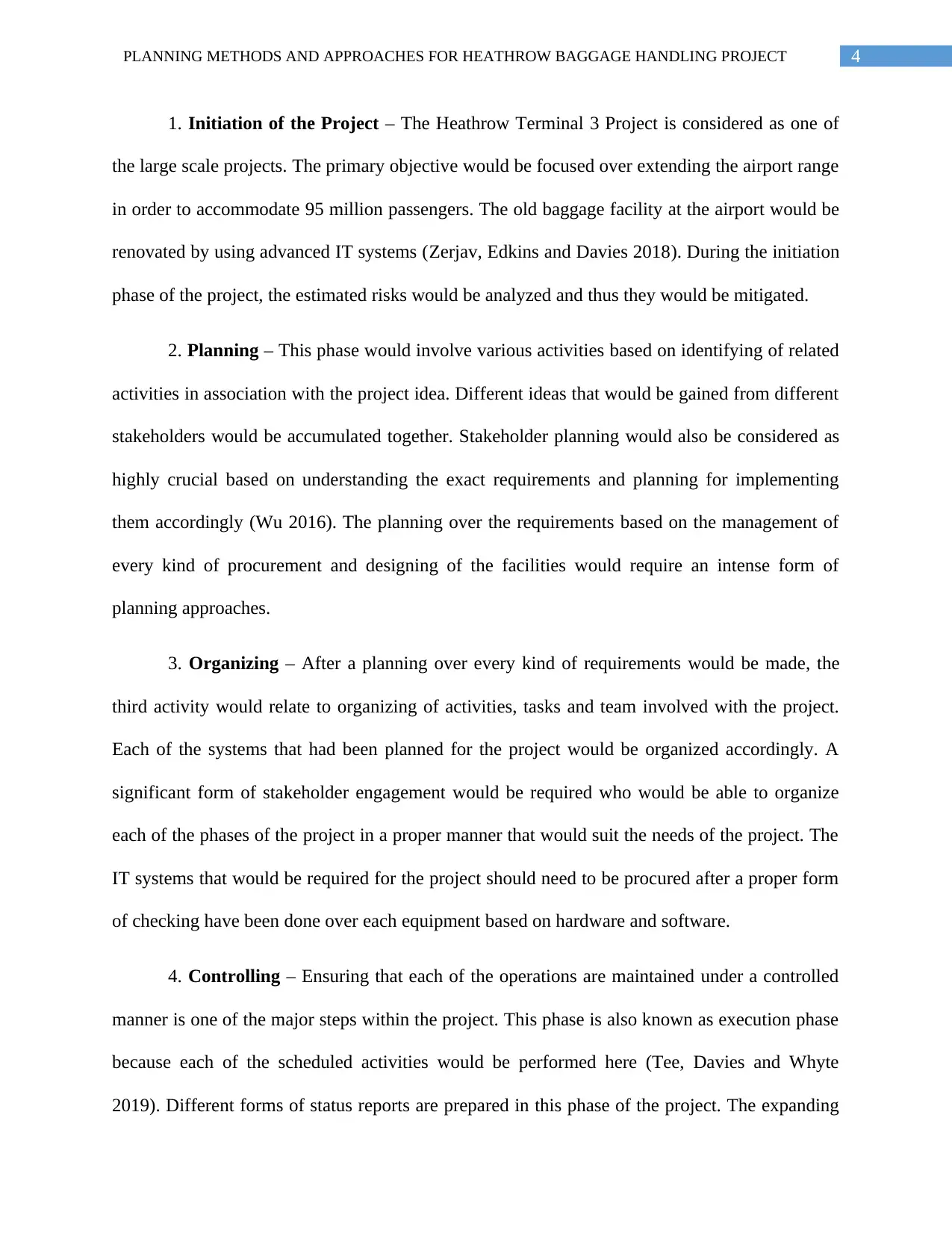
4PLANNING METHODS AND APPROACHES FOR HEATHROW BAGGAGE HANDLING PROJECT
1. Initiation of the Project – The Heathrow Terminal 3 Project is considered as one of
the large scale projects. The primary objective would be focused over extending the airport range
in order to accommodate 95 million passengers. The old baggage facility at the airport would be
renovated by using advanced IT systems (Zerjav, Edkins and Davies 2018). During the initiation
phase of the project, the estimated risks would be analyzed and thus they would be mitigated.
2. Planning – This phase would involve various activities based on identifying of related
activities in association with the project idea. Different ideas that would be gained from different
stakeholders would be accumulated together. Stakeholder planning would also be considered as
highly crucial based on understanding the exact requirements and planning for implementing
them accordingly (Wu 2016). The planning over the requirements based on the management of
every kind of procurement and designing of the facilities would require an intense form of
planning approaches.
3. Organizing – After a planning over every kind of requirements would be made, the
third activity would relate to organizing of activities, tasks and team involved with the project.
Each of the systems that had been planned for the project would be organized accordingly. A
significant form of stakeholder engagement would be required who would be able to organize
each of the phases of the project in a proper manner that would suit the needs of the project. The
IT systems that would be required for the project should need to be procured after a proper form
of checking have been done over each equipment based on hardware and software.
4. Controlling – Ensuring that each of the operations are maintained under a controlled
manner is one of the major steps within the project. This phase is also known as execution phase
because each of the scheduled activities would be performed here (Tee, Davies and Whyte
2019). Different forms of status reports are prepared in this phase of the project. The expanding
1. Initiation of the Project – The Heathrow Terminal 3 Project is considered as one of
the large scale projects. The primary objective would be focused over extending the airport range
in order to accommodate 95 million passengers. The old baggage facility at the airport would be
renovated by using advanced IT systems (Zerjav, Edkins and Davies 2018). During the initiation
phase of the project, the estimated risks would be analyzed and thus they would be mitigated.
2. Planning – This phase would involve various activities based on identifying of related
activities in association with the project idea. Different ideas that would be gained from different
stakeholders would be accumulated together. Stakeholder planning would also be considered as
highly crucial based on understanding the exact requirements and planning for implementing
them accordingly (Wu 2016). The planning over the requirements based on the management of
every kind of procurement and designing of the facilities would require an intense form of
planning approaches.
3. Organizing – After a planning over every kind of requirements would be made, the
third activity would relate to organizing of activities, tasks and team involved with the project.
Each of the systems that had been planned for the project would be organized accordingly. A
significant form of stakeholder engagement would be required who would be able to organize
each of the phases of the project in a proper manner that would suit the needs of the project. The
IT systems that would be required for the project should need to be procured after a proper form
of checking have been done over each equipment based on hardware and software.
4. Controlling – Ensuring that each of the operations are maintained under a controlled
manner is one of the major steps within the project. This phase is also known as execution phase
because each of the scheduled activities would be performed here (Tee, Davies and Whyte
2019). Different forms of status reports are prepared in this phase of the project. The expanding
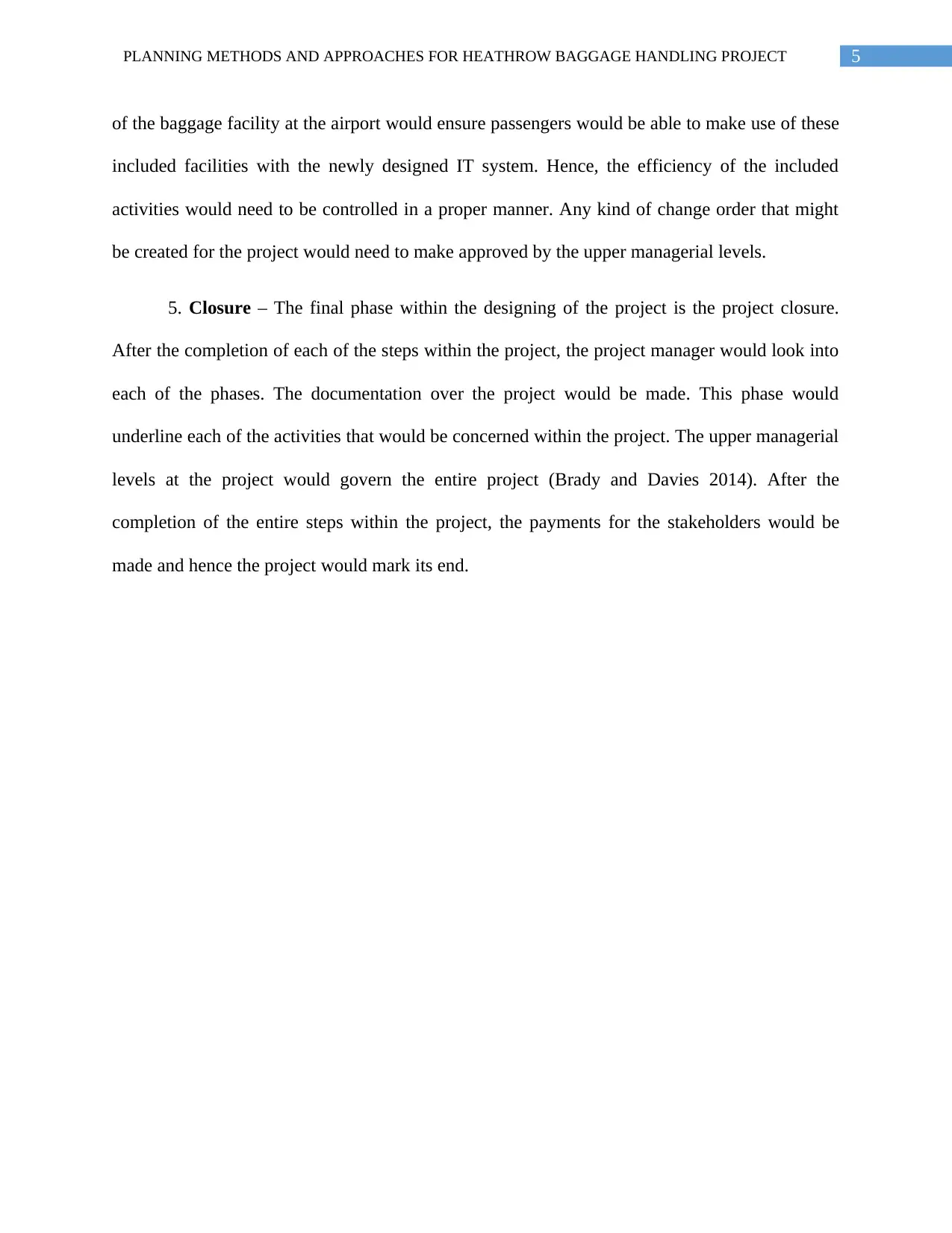
5PLANNING METHODS AND APPROACHES FOR HEATHROW BAGGAGE HANDLING PROJECT
of the baggage facility at the airport would ensure passengers would be able to make use of these
included facilities with the newly designed IT system. Hence, the efficiency of the included
activities would need to be controlled in a proper manner. Any kind of change order that might
be created for the project would need to make approved by the upper managerial levels.
5. Closure – The final phase within the designing of the project is the project closure.
After the completion of each of the steps within the project, the project manager would look into
each of the phases. The documentation over the project would be made. This phase would
underline each of the activities that would be concerned within the project. The upper managerial
levels at the project would govern the entire project (Brady and Davies 2014). After the
completion of the entire steps within the project, the payments for the stakeholders would be
made and hence the project would mark its end.
of the baggage facility at the airport would ensure passengers would be able to make use of these
included facilities with the newly designed IT system. Hence, the efficiency of the included
activities would need to be controlled in a proper manner. Any kind of change order that might
be created for the project would need to make approved by the upper managerial levels.
5. Closure – The final phase within the designing of the project is the project closure.
After the completion of each of the steps within the project, the project manager would look into
each of the phases. The documentation over the project would be made. This phase would
underline each of the activities that would be concerned within the project. The upper managerial
levels at the project would govern the entire project (Brady and Davies 2014). After the
completion of the entire steps within the project, the payments for the stakeholders would be
made and hence the project would mark its end.
⊘ This is a preview!⊘
Do you want full access?
Subscribe today to unlock all pages.

Trusted by 1+ million students worldwide
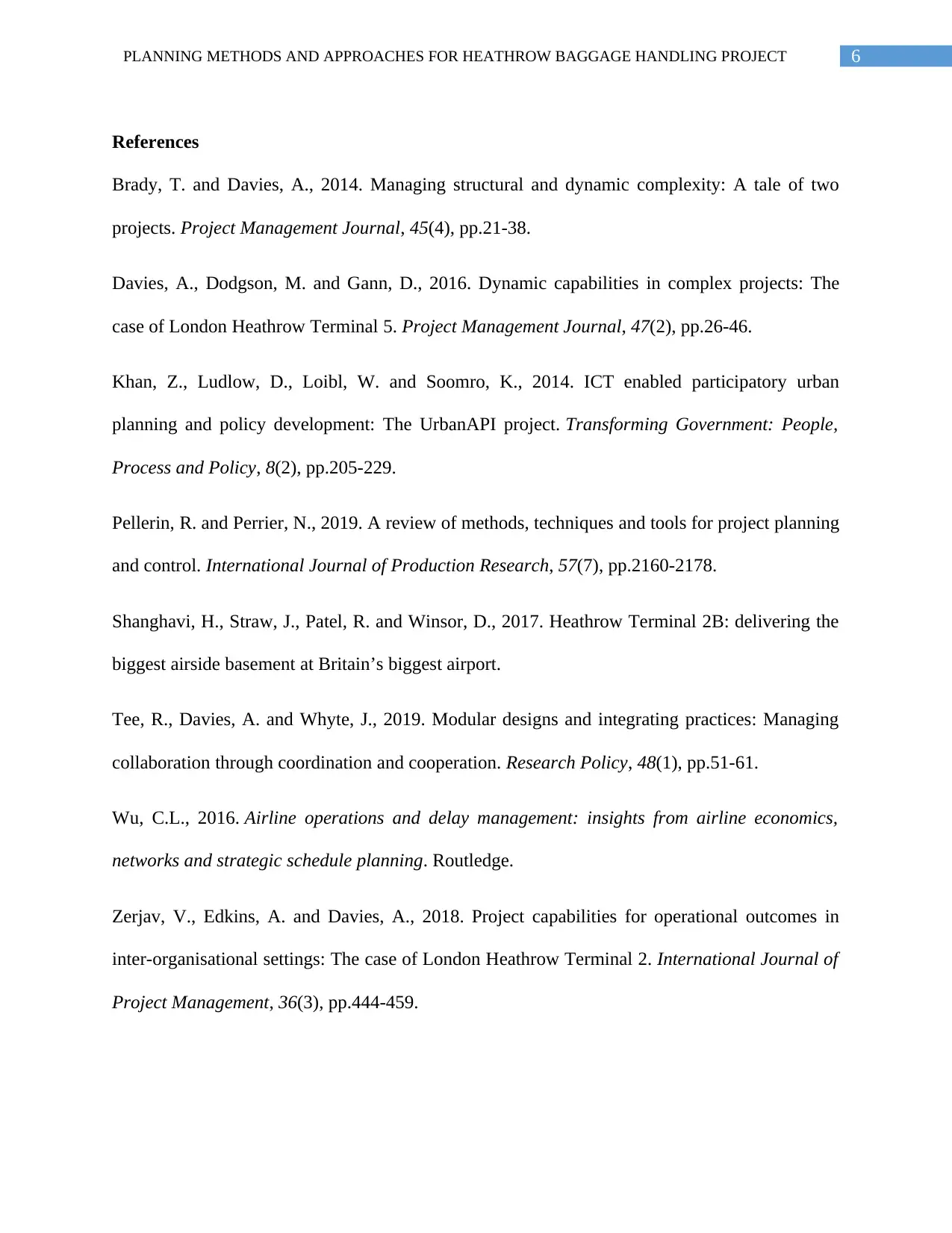
6PLANNING METHODS AND APPROACHES FOR HEATHROW BAGGAGE HANDLING PROJECT
References
Brady, T. and Davies, A., 2014. Managing structural and dynamic complexity: A tale of two
projects. Project Management Journal, 45(4), pp.21-38.
Davies, A., Dodgson, M. and Gann, D., 2016. Dynamic capabilities in complex projects: The
case of London Heathrow Terminal 5. Project Management Journal, 47(2), pp.26-46.
Khan, Z., Ludlow, D., Loibl, W. and Soomro, K., 2014. ICT enabled participatory urban
planning and policy development: The UrbanAPI project. Transforming Government: People,
Process and Policy, 8(2), pp.205-229.
Pellerin, R. and Perrier, N., 2019. A review of methods, techniques and tools for project planning
and control. International Journal of Production Research, 57(7), pp.2160-2178.
Shanghavi, H., Straw, J., Patel, R. and Winsor, D., 2017. Heathrow Terminal 2B: delivering the
biggest airside basement at Britain’s biggest airport.
Tee, R., Davies, A. and Whyte, J., 2019. Modular designs and integrating practices: Managing
collaboration through coordination and cooperation. Research Policy, 48(1), pp.51-61.
Wu, C.L., 2016. Airline operations and delay management: insights from airline economics,
networks and strategic schedule planning. Routledge.
Zerjav, V., Edkins, A. and Davies, A., 2018. Project capabilities for operational outcomes in
inter-organisational settings: The case of London Heathrow Terminal 2. International Journal of
Project Management, 36(3), pp.444-459.
References
Brady, T. and Davies, A., 2014. Managing structural and dynamic complexity: A tale of two
projects. Project Management Journal, 45(4), pp.21-38.
Davies, A., Dodgson, M. and Gann, D., 2016. Dynamic capabilities in complex projects: The
case of London Heathrow Terminal 5. Project Management Journal, 47(2), pp.26-46.
Khan, Z., Ludlow, D., Loibl, W. and Soomro, K., 2014. ICT enabled participatory urban
planning and policy development: The UrbanAPI project. Transforming Government: People,
Process and Policy, 8(2), pp.205-229.
Pellerin, R. and Perrier, N., 2019. A review of methods, techniques and tools for project planning
and control. International Journal of Production Research, 57(7), pp.2160-2178.
Shanghavi, H., Straw, J., Patel, R. and Winsor, D., 2017. Heathrow Terminal 2B: delivering the
biggest airside basement at Britain’s biggest airport.
Tee, R., Davies, A. and Whyte, J., 2019. Modular designs and integrating practices: Managing
collaboration through coordination and cooperation. Research Policy, 48(1), pp.51-61.
Wu, C.L., 2016. Airline operations and delay management: insights from airline economics,
networks and strategic schedule planning. Routledge.
Zerjav, V., Edkins, A. and Davies, A., 2018. Project capabilities for operational outcomes in
inter-organisational settings: The case of London Heathrow Terminal 2. International Journal of
Project Management, 36(3), pp.444-459.
1 out of 7
Related Documents
Your All-in-One AI-Powered Toolkit for Academic Success.
+13062052269
info@desklib.com
Available 24*7 on WhatsApp / Email
![[object Object]](/_next/static/media/star-bottom.7253800d.svg)
Unlock your academic potential
Copyright © 2020–2025 A2Z Services. All Rights Reserved. Developed and managed by ZUCOL.





